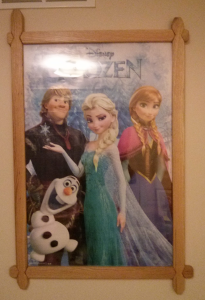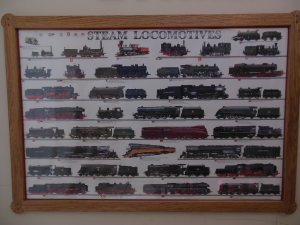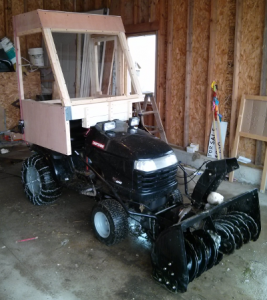But when Jesus saw it, he was indignant and said to them, “Let the children come to me; do not hinder them, for to such belongs the kingdom of God.” – Mark 10:14
This story starts an embarrassingly long time ago. Back in the summer of 2013 my folks were watching the kids up by their place by Lake Hubbard. My wife and I scooted over to Traverse City for a couple days and we stopped at the model train store downtown and found a poster with a number of steam engines on it. I had the intention of building a poster frame for my son at the earliest possible point in time. Thankfully this Christmas our daughter also got a Frozen poster from my folks. And the earliest possible time suddenly appeared.
The video above goes through the build processes in a fair bit of depth describing the build process for each of the poster frames, so much of this is going to be recap of the video.

All I knew at the beginning of the project is that I wanted to use through half lap joints for the frame. I had seen some recently, though I don’t recall where exactly, and really liked the idea. I also figured for something like a poster frame it might be stressing the strength of miter joints. I wanted to keep the design for a Frozen poster to seem something of a crystalline inspired shape which meant avoiding curves and keeping with a cooler palette. In the selection process for the wood I looked for some of the lightest red oak I had on hand and with less of the characteristic crowns usually found in oak species.
I came up with a simple design for the joints to appear as if a half diamond from the horizontal pieces were occluding the vertical pieces. This was done by removing that shape from the vertical pieces first, smoothing out the cuts, and removing the material for the top piece of the half lap joint. Then the actual upper piece was used to scribe the lines on the horizontal pieces so I would have something very close to match. In the end my skills with a handsaw, chisel, and file were not up to the task of making this joint as tight as I would have liked to have seen. But rather than call it a loss, I deepened the chamfer along the joint to add shadow in the joint so that the less than stellar joinery became less obvious. Additionally it seemed at that point that going for a less perfect frame might also mean leaving the random lengths of the pieces and just adding their own angled cuts on each. Almost snowflake like in appearance, as each one is unique.

Originally I thought this was going to be a tougher, but in the end it was much easier and the joints themselves were much tighter. I’m not sure if that is mostly do to some process changes (from experience with the first poster) which made it easier to do better joints or if it was easier due to a slightly different set of tools being used. I had originally planned on using a forstner bit to hog out the curves, but found it it was going to be tough to make it repeatable. Once I thought of using the spindle sander for the drill press I had decided to use the bandsaw to hog out the material. The working of the joining pieces went a little better by hogging out extra material with the dado stack and then using a chisel and file. Since most of the work was done by the table saw it was just detail work on the joint instead of doing all of the work. That allowed for finer adjustment of the joint compared to the more aggressive work that I had done on the Frozen poster frame.
Perhaps one of the hardest parts of this build came after completing the poster frames. I found I had 45Gb of video sitting on the fileserver and enormous chunks of missing video (such as the completion of the Frozen poster frame). In the end I figure I spent about the same amount of time on the video as I spend on the project. This was the first video I actually explained what I was working on with a voice over rather than just stringing clips together and adding music. The whole process of sorting the video, recording audio, and finally pacing the video clips took a considerable amount of time. I am impressed with the rate at which some other content producers are able to put videos out. I suppose some of that comes with experience.
Music Links
http://freemusicarchive.org/music/Josh_Woodward/
http://freemusicarchive.org/music/Jahzzar/
